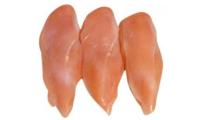Lethal combination reduces bacteria on chicken

A mixture of organic acids and plant extracts is enough to greatly reduce pathogenic bacteria on chicken breast meat. Add some irradiation to the mix and it makes a lethal combination against the bacteria.
Food Safety Consortium researchers at the University of Arkansas System’s Division of Agriculture found that they could greatly reduce E. coli O157:H7, Listeria monocytogenes and Salmonella Typhimurium in the chicken breast meat by infusing combinations of organic acids –acetic, citric, lactic, malic and tartaric – into the meat. The experiments were also performed with extracts from green tea and grape seeds in combination with the acids.
Three of the organic acids – malic, citric and tartaric – were most effective against S. Typhimurium and E. coli O157:H7, more than against L. monocytogenes. With irradiation factored in, the results were significant against all the pathogens.
“We want to determine the least amount of plant extracts that we can use and the least amount of irradiation dosage to get the best inhibitory effect,” said Navam Hettiarachchy, a UA food science professor who supervised the project.
Previous research by Hettiarachchy’s research team showed that extracts from grape seed and green tea reduced L. monocytogenes to undetectable levels when applied in combination with nisin, a bacteriocin recognised as a safe food preservative.
The researchers are also using the plant extracts to serve as antioxidants, which minimises lipid oxidation. Lipid oxidation is a process that causes meat quality to deteriorate by adversely affecting characteristics such as flavour, colour and texture.
Hettiarachchy said the research team has examined the effects of irradiation on the chicken’s colour and texture and found no significant change.
The research is continuing, but Hettiarachchy said a poultry company has already expressed interest in the project’s findings. Irradiation, however, has not yet been applied widely in the US as many companies have worried about potential resistance among consumers.
Hettiarachcy suggested that labels on irradiated products could have a brief explanation of irradiation to educate consumers.
“I am hopeful that with time the public will become aware of irradiation processing so that they accept irradiation in processing poultry and meat products for safety against pathogens,” Hettiarachchy said. “A new education component is very important and may be the key for acceptance for irradiated food products by the consumer.”
Related link:
University of Arkansas, Food Safety Consortium
Join 31,000+ subscribers
Subscribe to our newsletter to stay updated about all the need-to-know content in the poultry sector, three times a week. Beheer
Beheer








 WP Admin
WP Admin  Bewerk bericht
Bewerk bericht